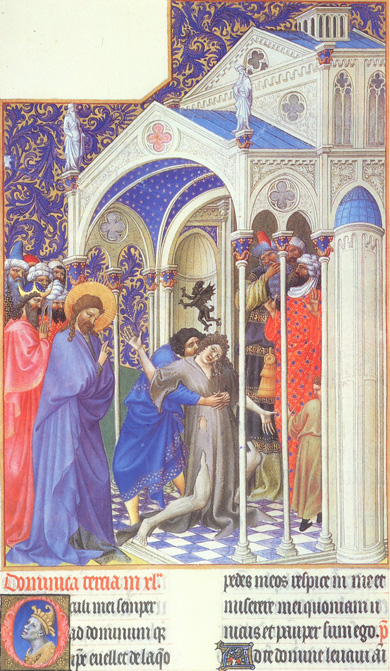Witnessing a seizure is a very frightening experience. Parents who witness seizures in children fear for their child’s life. It is extremely traumatic. Even now, as a trained professional, knowing all the steps I could ever need to take care of the problem, I will feel my heart rate climb with a knot in my stomach as adrenaline starts to flood my system to this day.
So it’s not surprising that in the past, seizures were thought to be caused by demonic possession. Many an epileptic in the middle ages were treated with exorcism.

Matthew 17:15- "Lord, have mercy on my son: for he is lunatick, and sore vexed: for ofttimes he afalleth into the fire, and oft into the water."
More recently, many in the scientific world have tried to paint religion itself as founded on epilepsy and a diseased mind, as the religious experience of everyone from Mohammed to Joseph Smith have been ascribed to an epileptic fit. Unfortunately, the EEG was not hooked up during said events, so the world may never know. The insinuation and prejudice against the “diseased mind” are still very much at play in these modern science based accusations. It seems we still want to call those we feel deluded possessed by our modern day demons.
(Note- see this post for an excellent recent excoriation of this mindset.)
With the advent of modern medicine we have started to get a handle on what is happening in the brain during a seizure. We know a little group of renegade neurons somewhere in the brain start a regular firing pattern that recruits more and more of the brain until the signal grows so strong it wipes out all regular brain activity. The tendency for this to happen periodically is known as epilepsy.
When interviewing the general public, however, an amazing amount of stigma remains in regard to epilepsy. This has generally improved slowly over time. In 1949, a Gallup poll revealed 57% of Americans thought epilepsy was a form of insanity, our own modern day equivalent of demonic possession. By 1979, the percentage decreased to around 8%.
In 1949, only 45% of people thought an epileptic could hold employment. Today 80% believe an epileptic can work. Still, finding employment can be difficult when one in five potential employers thinks you are inelegible to start with. In 1987, 92% of Americans were aware of epilepsy, a third of those surveyed thought epilepsy made other people think less of them or their families, and 12% thought people with epilepsy should never have children.
Considering how most epilepsy is quite treatable and controllable, and not genetically acquired, that last statistic is one of the most troubling. Even in our “enlightened” age, so many of us are troubled by the possessed. Many don’t want to see them propogate their inferior genes, or trouble us in the workplace.
Even worse is epilepsy as seen through the eyes of a child’s peer group. In 2006, a study by C. Cheung in the Journal of Child Neurology found that when asked, most teenagers agreed that Epilepsy commonly causes mental handicap, frequently leads to self injury and death, that people often injure bystanders when having a seizure, and that persons with epilepsy are less honest, popular, fun, and adept at sports than other teens.
In case you were wondering, all of these impressions are wildly exaggerated and not supported by reality. The fact is any of us, in the right circumstances and conditions can have a seizure. The dividing line between us and epileptics is actually that the seizures haven’t happened to “regular, healthy people” yet. But don’t fear, epilepsy ocurrence spikes a second time after childhood in old age. We all may get our chance.
The vast majority of people are not killed or injured by their seizures. Such events are rare. Even more rare is being injured by standing next to someone with a seizure. Yet, so many fear that the demons are contagious.
These teenagers considered Epilepsy as socially disabling as HIV infection or leukemia, ranking it worse than any condition other than Down syndrome. It was considered worse than asthma, diabetes, migraines, or arthritis.
This percieved stigma aggravates real problems as a child ages. Parents that fear their child is dying subtly lower their expectations for the child. Very often, children with seizures acquire vulnerable child syndrome, even when their seizures stop and they go off of medications as they grow up.
The end result is that even in this majority of epileptics, devoid of medication or seizures for many years, unemployment is higher. They are less likely to go to college than people of the same socioeconomic bacground and intelligence. They are less likely to marry or have children (silanpaa M, shinnar S, NEJM 1998; 38:708). In the end, it seems those 12% who want to stop epilepsy gene spread and contact in the workplace are winning. It is aggravating as a child neurologist to know that even when I have done my job and stopped the demons, the stigma continues to limit these children far beyond what their condition demands. In the end, curing the disease is not enough. The demons will continue to haunt them even after the body is healed. My question is, whose demons are they, theirs or the rest of society? It is evident to me that we are not as far beyond the superstition and misunderstanding of ages past as we would like to believe.
Tagged: child neurology, demons, epilepsy, exorcism, Joseph Smith, limitation, mohammed, prejudice, religion, seizures, stigma, superstition, visions, vulnerable child
Continue reading at the original source →



